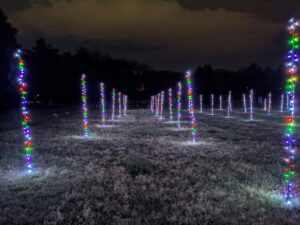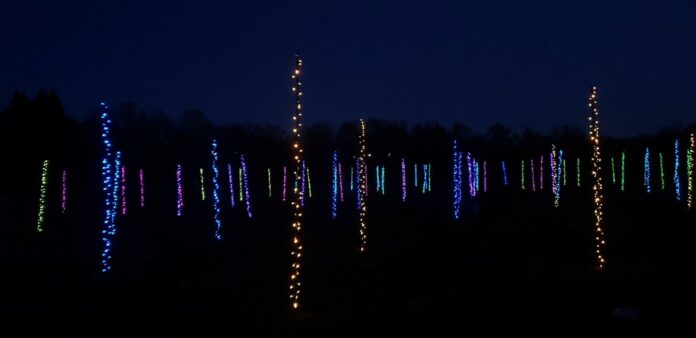HUNTSVILLE – Students from the University of Alabama in Huntsville recently designed and deployed an interactive light show for the Huntsville Botanical Garden. The installation was completed as part of a senior design project.

The light show design project was created by four UAH engineering students: team lead Steven Byrd, software co-leads Savannah Flaherty and Trey Thompson, and hardware lead Tristan McCarver. The project came about through a connection Byrd had as the lighting design and programming manager at the Botanical Garden.
“Steven Byrd, the Chargin’ RGBs design project team lead, works and was working in the position of lighting design and programming lead at the beginning of the semester,” said Dennis Hite, a senior lecturer in the UAH department of electrical and computer engineering. “Within this position, Steven supports all projects related to light shows at the Garden, including new technology additions to Galaxy of Lights.
“With the support of Garden leadership, the addition of newer light technologies to Galaxy
of Lights in 2021 paved the way for technology to be worked on and invested in for the
Senior Design Project. Tristan McCarver, the hardware lead, helped with hardware selections that facilitated a truly interactive light show, while Savannah Flaherty and Trey Thompson, software co-leads, supported software development and testing.”

“The design concept uses eight passive infrared sensors,” Hite said. “These sensors sense a thermal signature and measures this heat in the infrared region of the optical spectrum. A person walking by will trigger the sensor, making these PIR sensors very useful for an interactive light show display.
“When an object is within the range and field of view of the sensor, the voltage goes ‘high,’ and when the object passes the sensor, the voltage goes ‘low.’ In a high voltage state, the light show turns ‘on,’ and in a low voltage state, the light show turns ‘off.’”
The PIR sensors have a range of 20 feet and require 5 to 12 volts of DC current to operate.
The students arranged rebar poles in a grid pattern with the light show commands programmed to be different and specific to each of the eight sensors.
“From the perspective of engineering, the project was undertaken to enhance engineering
skills by using what was learned within classes at UAH, as well as new skills learned, on a
real-world application,” Hite said. “Accomplishing a project for a class grade and
accomplishing a project to be used in the real world are two entirely different battles, and
each come with their own set of challenges.”
All work was performed as part of an Electrical Engineering Senior Design team project
during their senior design course.
“This project not only challenged our engineering skills, but it also taught us team skills
only learned within the real world,” Hite said. “These skills involved budget building,
schedule planning and problem solving for a large-scale project, time management and
working for customers who invest money into the project.”
Don’t miss out! Subscribe to our email newsletter to have all our smart stories delivered to your inbox.



